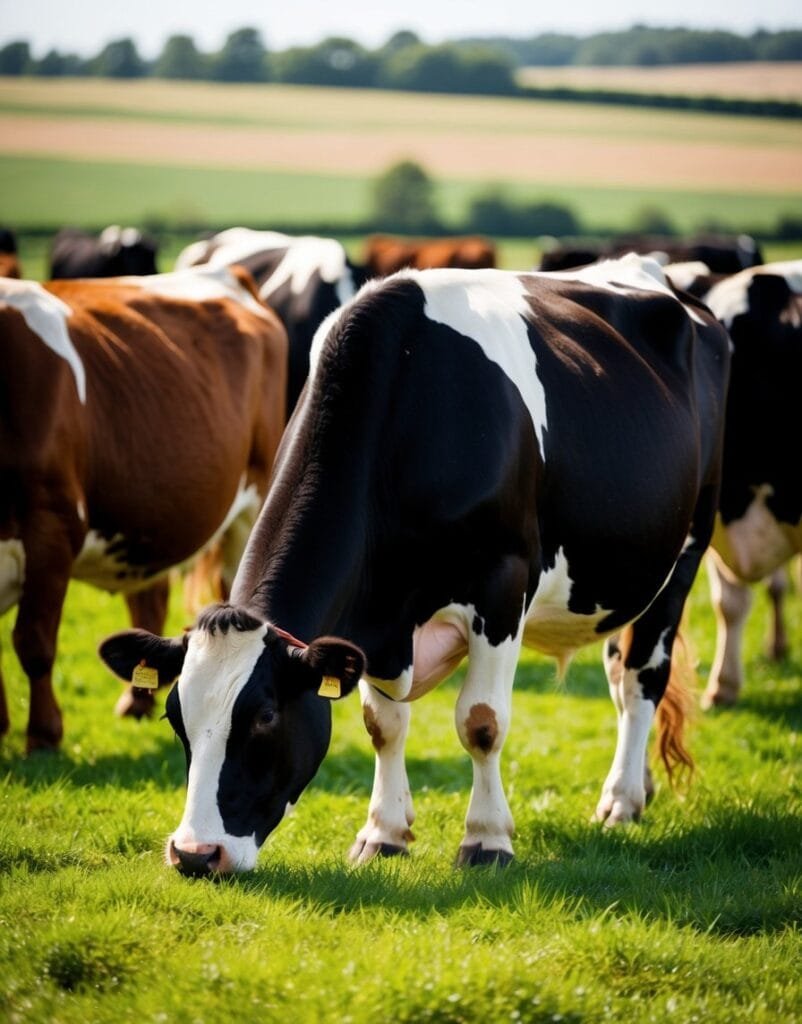Cattle nutrition is the science of providing the right balance of nutrients to support the health, growth, reproduction, and productivity of cattle. Proper nutrition is critical for maintaining optimal performance, whether the cattle are raised for beef production, milk production, or as draft animals. This detailed guide explores all aspects of cattle feeding strategies, from the basic requirements to practical feeding strategies.

1. The Basics of Cattle Nutrition
Cattle are ruminants, meaning they have a complex stomach with four compartments: the rumen, reticulum, omasum, and abomasum. This system allows them to digest fibrous plant material that non-ruminants cannot. The rumen is home to billions of microbes (bacteria, protozoa, fungi) that break down plant material, converting it into nutrients usable by the animal.
The nutritional needs of cattle are divided into six main categories:
a. Water
- Importance: Water is the most critical nutrient, essential for digestion, temperature regulation, nutrient transport, and waste elimination.
- Requirements: Cattle typically consume 10-20 gallons per day, depending on their size, lactation status, activity level, and environmental temperature.
b. Carbohydrates
- Role: Provide energy, the main driver for maintenance, growth, reproduction, and milk production.
- Sources:
- Forages: Grass, hay, silage, and pasture.
- Grains: Corn, barley, oats.
- By-products: Beet pulp, molasses.
- Fiber Importance: The rumen microbes break down fiber into volatile fatty acids (VFAs), a primary energy source for cattle.
c. Proteins
- Role: Crucial for muscle development, reproduction, milk production, and enzyme synthesis.
- Sources:
- Forages: Alfalfa, clover.
- Concentrates: Soybean meal, canola meal, cottonseed meal.
- Non-Protein Nitrogen (NPN): Urea, ammonium salts (require proper management to avoid toxicity).
- Microbial Protein: Rumen microbes synthesize protein that is digested by the cow later.
d. Fats
- Role: A dense energy source and important for reproductive health.
- Sources: Tallow, oilseeds (soybeans, flaxseed), and supplements.
- Limits: Excess fat can disrupt rumen fermentation; typically kept under 5-6% of the total diet.
e. Vitamins
- Essential Vitamins:
- Fat-Soluble: A, D, E, and K.
- Water-soluble: B vitamins (mostly synthesized by rumen microbes, but supplementation may be needed in high-production animals).
- Sources: Green forages, premixes, supplements.
f. Minerals
- Macro-minerals: Calcium, phosphorus, magnesium, potassium, sulfur, sodium, and chlorine.
- Micro-minerals: Zinc, copper, manganese, iodine, selenium, cobalt, and iron.
- Sources: Mineral blocks, premixes, and natural feed.
2. Nutritional Needs Across Life Stages

a. Calves
- The nutritional focus is on growth and immune development.
- Colostrum: First milk provides essential antibodies and nutrients.
- Diet transitions from milk to starter feed (grain and hay) by 6-8 weeks of age.
b. Growing Cattle
- Require a diet high in energy and protein to promote muscle and skeletal growth.
- Balanced forage-concentrate rations ensure proper growth without excessive fat deposition.
c. Breeding and Pregnant Cows
- Require sufficient nutrients for reproductive health and fetal development.
- In late gestation, energy demands increase by 20-30%.
d. Lactating Cows
- Nutritional demand is highest during lactation due to milk production.
- High-quality forages and energy-dense feeds are critical to meet their needs.
e. Finishing Cattle (Beef)
- Diets are formulated for rapid weight gain and fat deposition.
- High-grain diets (corn-based) are common, with limited roughage.
3. Types of Feed for Cattle
a. Forages
- Role: Base of the diet, providing fiber for rumen health.
- Examples: Pasture grass, hay, silage.
- Quality Indicators: Leafiness, color, moisture content, absence of mold.
b. Concentrates
- Role: Supplement energy and protein.
- Examples: Grains, protein meals, by-products.
- Risks: Overfeeding can lead to acidosis, bloat, or laminitis.
c. Supplements
- Used to provide additional vitamins, minerals, and specific nutrients lacking in the base diet.
d. Additives
- Include probiotics, prebiotics, ionophores (improve feed efficiency), and buffers (stabilize rumen pH).
4. Ration Formulation
Balancing a Ration
- A balanced ration provides all nutrients in the correct proportions to meet the animal’s needs.
- Factors to consider:
- Nutrient Requirements: Vary by age, size, production stage, and environment.
- Feed Availability and Cost: Use local, cost-effective feeds.
- Palatability and Digestibility: Ensures intake and nutrient absorption.
Ration Components
- Dry Matter Intake (DMI): Amount of feed consumed minus water.
- Total Digestible Nutrients (TDN): Measure of energy.
- Crude Protein (CP): Protein content of the feed.
5. Challenges in Cattle Nutrition
a. Nutritional Disorders
- Bloat: Gas build-up in the rumen; often due to lush legumes or high-grain diets.
- Acidosis: Caused by rapid fermentation of high-starch feeds.
- Milk Fever: Calcium deficiency in lactating cows.
- Grass Tetany: Magnesium deficiency in cattle grazing lush pastures.
b. Environmental Impact
- Nutrient management in cattle is essential to minimize nitrogen and phosphorus runoff.
- Efficient feeding strategies reduce methane emissions from cattle.
c. Feed Costs
- Feeds often account for 50-70% of production costs; efficient feeding improves profitability.
Learn about Expected Progeny Differences (EPDs).
6. Practical Tips for Feeding Cattle
- Regularly test forages and water quality to understand nutrient content.
- Monitor body condition scores (BCS) to adjust feeding programs.
- Provide clean water and free-choice mineral supplements.
- Rotate pastures to maintain forage quality and prevent overgrazing.
- Use feed additives judiciously to enhance productivity.
7. Advances in Cattle Nutrition
- Precision Feeding: Use of software to optimize rations based on specific herd needs.
- Alternative Feeds: Use of by-products like distillers’ grains and brewers’ waste.
- Genomics: Identifying cattle with better feed efficiency traits.
- Sustainable Practices: Improved grazing systems and feed additives to reduce methane emissions.
Conclusion
Cattle nutrition is both an art and a science, requiring careful balance and continuous monitoring. By understanding cattle’s unique digestive systems and their varying nutritional needs, producers can develop effective feeding strategies that maximize productivity, support animal health, and enhance sustainability whether raising cattle for beef or milk, a well-planned nutrition program is key to achieving success in the livestock industry.
